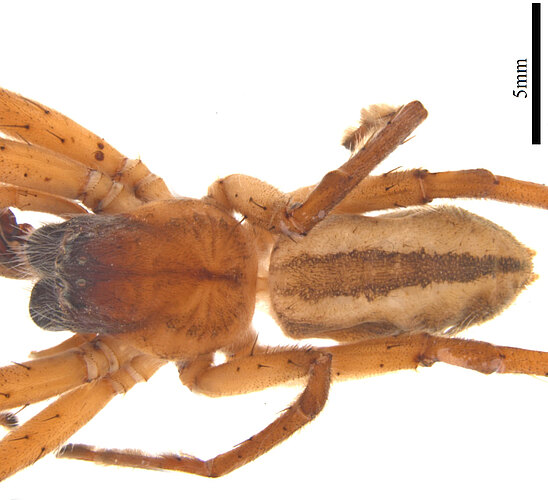Huntsman Spider Neosparassus FP-320 ('gladius')
Fauna Portal species: 320Diagnosis
(by J. Schubert): The male of Neosparassus FP-320 can be distinguished from all other valid Neosparassus species by the following combination of characters: opisthosoma distinctly elongated and marked mediodorsally with a lanceolate longitudinal brown stripe, tapering posteriorly; ventral opisthosoma marked with trapezoidal badge which tapers towards posteriorly and fades from black to red-brown; carapace longer than wide (approximately x times longer than wide); RTA of pedipalp sickle-shaped with a rounded apex; dorsal ridge of RTA minute and rounded, situated at basal surface of RTA embolus in x coils. Neosparassus FP-320 most closely resembles Neosparassus macilentus by their shared elongated opisthosomata marked with a longitudinal stripe, however, can be readily separated by the presence of a ventral opisthosomal badge (vs absent in Neosparassus macilentus).
Fauna Portal Reference
Australia
- Western Australia
Fauna Portal Records
The map shows all records that have been verified as part of the Fauna Portal project and may not represent the true distribution of a species. Specifically, for described species, check the link to the Atlas of Living Australia on this page for potential wider distributions. Fauna Portal Reference specimens and Linnean types are shown in red. If you identified a specimen that exceeds the distribution of an undescribed species as illustrated here, please contact the Fauna Portal team who can assist with the lodgement of the specimen in a public institution and display on the map.
CATAAAGATATTGGAACTTTATATTTAATTTTTGGTGTTTGAGCAGCTATAGTTGGAACAGCTATAAGAGTATTGATTCGTGCTGAATTAGGACAATGTGGAAGTTTGTTAGGAGATGATCATTTATATAATGTAATTGTTACAGCTCATGCGTTTGTGATGATTTTTTTTATAGTAATACCTATTATAATTGGTGGGTTCGGTAATTGATTAGTTCCTTTAATACTAGGGGCGCCTGATATAGCATTTCCTCGAATAAATAATTTGAGTTTTTGGTTACTCCCTCCATCATTATTATTATTGTTTGTATCCTCAATAGTAGAGATAGGGGTTGGTGCAGGTTGAACTGTATATCCTCCTTTAGCTTCATCTGTAGGCCATGCTGGAAGATCAGTAGATTTTGCTATTTTTTCTTTACATTTAGCAGGAGCTTCTTCTATTATAGGAGCTATTAATTTTATTTCTACTATTATTAATATACGTTCACCTGGGAT-GAGAATGGAAAAAGTTCCTTTGTTTGTGTGATCAGTATTGATTACAGCAATTTTACTTTTATTATCATTACCTGTATTAGCAGGAGCTATTACAATATTGTTAACTGATCGTAATTTTAATACTTCGTTTTTTGATCCAGCAGGGGGAGGGGATCCTGTATTATTCCAGCATTTGTTTTGATTTTTTGGTCAC
Araneae (Spiders)
- Actinopodidae
- Anamidae
- Araneae fam. indet.
- Araneidae
- Archaeidae
- Argyronetidae
- Arkyidae
- Barychelidae
- Cheiracanthiidae
- Clubionidae
- Corinnidae
- Cycloctenidae
- Deinopidae
- Desidae
- Dictynidae
- Filistatidae
- Gnaphosidae
- Halonoproctidae
- Hersiliidae
- Idiopidae
- Lamponidae
- Linyphiidae
- Lycosidae
- Mimetidae
- Miturgidae
- Mysmenidae
- Nicodamidae
- Oecobiidae
- Oonopidae
- Oxyopidae
- Philodromidae
- Pholcidae
- Pisauridae
- Prodidomidae
- Salticidae
- Scytodidae
- Segestriidae
- Selenopidae
- Sparassidae
- Symphytognathidae
- Tetrablemmidae
- Tetragnathidae
- Theridiidae
- Thomisidae
- Trachelidae
- Trachycosmidae
- Trochanteriidae
- Uloboridae
- Zodariidae
- Zoropsidae
All classes
- Arachnida
- Crustacea
- Entognatha
- Gastropoda
- Insecta
- Orthoptera - Caelifera (Grasshoppers)
- Hymenoptera excl. Formicidae (bees and wasps)
- Blattodea s. str. (Cockroaches)
- Coleoptera (Beetles)
- Dermaptera (earwigs)
- Diptera (flies, mosquitos)
- Entomobryomorpha (slender springtails)
- Hemiptera - Heteroptera (True Bugs)
- Hemiptera - Sternorrhyncha (aphids, scales etc.)
- Hemiptera - Auchenorrhyncha (cicadas, planthoppers)
- Hymenoptera - Formicidae (Ants)
- Trichoptera (Caddisflies)
- Zygentoma (silverfish)
- Myriapoda

